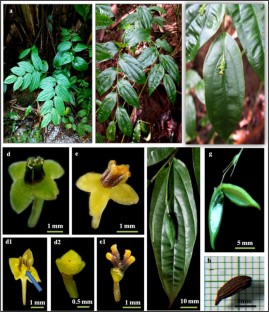Chromosomal characteristics in two different sexual phenotypes of Stichoneuron membranaceum
Research Articles | Published: 12 November, 2019
Online ISSN : 2229-4473.
Website:www.vegetosindia.org
Pub Email: contact@vegetosindia.org
First Page: 26
Last Page: 30
Views: 1040
Keywords:
Androdioecious, Hermaphrodite, Karyotype, Stemonaceae,
Stichoneuron membranaceum
Abstract
The present investigation has been focussed on mitotic and meiotic chromosome study of androdioecious Stichoneuron membranaceum from the state of Tripura. The somatic chromosome number in both the sexual phenotypes was found to be 2n = 18 having one pair of chromosomes bearing secondary constriction. Meiosis is regular and the presence of nine bivalents in pollen mother cells of male and hermaphrodite flowers suggest that the basic chromosome number is X = 9. The accentuated chromosome homology in androecious and hermaphrodite plants of S. membranaceum is the intrinsic character of their karyotypes.

(*Only SPR Members can get full access. Click Here to Apply and get access)
References
- Barbhuiya HA, Gogoi R (2010) Plant collections from Bangladesh in the Herbarium at Shillong (Assam), India. Bangl J Plant Taxon 17(2):141–165. https://doi.org/10.3329/bjpt.v17i2.6695
- Brem B, Seger C, Pacher T, Hofer O, Vajrodaya S et al (2002) Feeding deterrence and contact toxicity of Stemona alkaloids—a source of potent natural insecticides. J Agric Food Chem 50:6383–6388
- Deb DB (1983) The flora of Tripura State, vol II. Today and Tomorrows’ Printers and Publishers, New Delhi
- Duyfjes BEE (1991) Stemonaceae and Pentastemonaceae; with miscellaneous notes on members of both families. Blumea 36:239–252
- Greger H (2006) Structural relationships, distribution and biological activities of Stemona alkaloids. Planta Med 72:99–113. https://doi.org/10.1055/s-2005-916258
- Hooker JD (1892) The flora of British India, vol VI. L. Reeve & Co, London
- Huziwara Y (1962) Karyotype analysis in some genera of compositae. VII. Further studies on the chromosome of Aster. Am J Bot 49:116–119. https://doi.org/10.1002/j.1537-2197.1962.tb14916.x
- Inthachub P, Vajrodaya S, Duyfjes BEE (2009) Review of the genus Stichoneuron (Stemonaceae). Edinburgh J Bot 66:213–228. https://doi.org/10.1017/S0960428609005368
- Kaltenegger E, Brem B, Mereiter K, Kalchhauser H, Kählig H et al (2003) Insecticidal pyrido[1,2-a] azepine alkaloids and related derivatives from Stemona species. Phytochemistry 63:803–816. https://doi.org/10.1016/S0031-9422(03)00332-7
- Kubitzki K (1998) Stemonaceae. The families and genera of vascular plants. Springer, Berlin, Heidelberg
- Levan A, Fredga K, Sandbery A (1964) Nomenclature for centromeric position on chromosomes. Heriditas 52:201–220. https://doi.org/10.1111/j.1601-5223.1964.tb01953.x
- Majumdar K, Datta BK (2013) Fruit and seed discoveries in Stichoneuron membranaceum Hook. F. (Stemonaceae): an endemic to Indo-Myanmar. Modern Phytomorphology 3:39–44. https://doi.org/10.5281/zenodo.161592
- Mao AA, Hynniewta TM, Sanjappa M (2009) Plant wealth of northeast India with reference to ethnobotany. Indian J Trad Knowl 8:96–103
- Mungkornasawakul P, Pyne SG, Jatisatienr A, Supyen D, Jatisatienr C, Lie et al (2004) Phytochemical and larvicidal studies on Stemona curtisii: structure of a new pyrido[1,2- a] azepine Stemona alkaloid. J Nat Prod 67:675–677. https://doi.org/10.1021/np034066u
- Myers N, Mittermier RA, Mittermier CG, da Fonseca GAB, Kent J (2000) Biodiversity hotspots for conservation priorities. Nature 40:853–858. https://doi.org/10.1038/35002501
- Oginuma K, Horiuchi K, Fukuhura T (2001) Karyomorphology of two genera in Stemonaceae. Acta Phytotax Geobot 52:57–64
- Paszko A (2006) A critical review and a new proposal of karyotype asymmetry indices. Plant Syst Evol 258:39–48. https://doi.org/10.1007/s00606-005-0389-2
- Peruzzi L, Eroglu HE (2013) Karyotype asymmetry: again how to measure and what to measure? Compar Cytogenet 7:1–9. https://doi.org/10.3897/CompCytogen.v7i1.4431
- Pilli RA, Ferreira de oliveira MC (2000) Recent progress in the chemistry of the Stemona alkaloid. Nat Prod Rep 17:117–127. https://doi.org/10.1039/A902437I
- Pilli RA, Rosso GB, De Oliveira MDCF (2010) The chemistry of Stemona alkaloids: an update. Nat Prod Rep 27:1908–1937. https://doi.org/10.1039/C005018K
- Ramli RA (2015) Phytochemical biological studies on selected Stemona and Stichoneuron species (Stemonaceae). Doctoral Thesis University of Wollongong
- Sanguanpong U, Hummel HE (2008) Toxicity of Stemona root against onion cutworm by using different contacting methods and solvents. Common Agri App Bio Sci 73:459–467
- Sharma AK, Sharma A (1980) Chromosome technique theory and practical, 3rd edn. Butter works Ltd, London
- Stebbins GL (1971) Chromosomal evolution in higher plants. Edward Arnold Ltd, London
- Stöger EA (1999) Pharmacopoeia of Chinese Medicine. Monographs of the Arznbeibuches of the People’s Republic of China 1990 and 1995. Deutscher Apotheker Verlag, Stuttgart
- Tanaka N, Tanaka N, Ohi-Toma T, Murata J (2007) New or noteworthy plant collections from Myanmar (2). Aponogeton lakhonensis, Cryptocoryne cruddasiana, C. crispatula var. balansae and Stichoneuron membranaceum. J Jpn Bot 82:266–273
- Watanabe K, Yahara T, Kosuge K (1999) Chromosomal evolution in the genus Brachyscome (Asteraceae, Astereae): stetistical tests regarding correlation between changes in karyotype and habit using phylogenetic information. J Plant Res 112:145–161. https://doi.org/10.1007/PL00013869
- Xu YT, Shaw PC, Jiang RW, Hon PM, Chan YM et al (2010) Antitussive and central respiratory depressant effects of Stemona tuberosa. J Ethnopharmacol 128:679–684. https://doi.org/10.1016/j.jep.2010.02.018
- Zarco CR (1986) A new methods for estimating karyotype asssymetry. Taxon 35:526–530. https://doi.org/10.2307/1221906
Acknowledgements
The first author is grateful to the DBT, Government of India for JRF Fellowship.
Author Information
Cytogenetics and Plant Biotechnology Laboratory, Department of Botany, Tripura University (A Central University), Suryamaninagar, India
adhikarisupriya.91@gmail.com
Cytogenetics and Plant Biotechnology Laboratory, Department of Botany, Tripura University (A Central University), Suryamaninagar, India
Cytogenetics and Plant Biotechnology Laboratory, Department of Botany, Tripura University (A Central University), Suryamaninagar, India